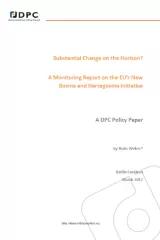Substantial Change on the Horizon? A Monitoring Report on the EU’s New Bosnia and Herzegovina Initiative
In November 2014, Germany and the United Kingdom launched a new policy initiative for Bosnia and Herzegovina (BiH). One month later, the European Union adopted the initiative as its own new EU initiative for BiH. Earlier, in February 2014, violent social protests had broken out in BiH and marked the failure of the EU’s previous policy approach in catalyzing real change in the country. At the same time, the protests drew new attention in the West to continuing problems in BiH. This enabled Berlin and London, whose dispute over the correct course of action to take in BiH had blocked the Union from having any meaningful policy, to get together behind a joint initiative. The focus of the new initiative was on structural socio-economic reform. Sensitive political issues like constitutional reform were pushed aside – for consideration at a later stage in enlargement – in order to unblock BiH’s long stalled EU integration process.
From a distance, the initiative may appear successful; in September 2016, less than two years after the start of the new initiative, the Union’s General Affairs Council (GAC) referred BiH’s membership application to the European Commission to prepare an Opinion. This marked the last of three steps in the EU integration process, originally foreseen as a reward for the fulfillment of certain reform conditions. This was followed by the entering into force of the long-delayed Stabilisation and Association Agreement (SAA) and BiH’s official application for membership. In addition, the centerpiece of the initiative, the so-called Reform Agenda was agreed and implementation initiated.
Product details
Table of contents
Executiev Summary
I. INTRODUCTION
II. STEPS UNDERTAKEN WITHIN THE EU-INITIATIVE
Step 1: Written Commitment – SAA enactment
Reform Agenda compilation
Step 2: Non-credible membership application by self-invitation
Towards Step 3: Commissioner Hahn’s March 2016 conditions, Brussels deadline(s)
Condition One: Reform Agenda implementation progress
Condition Two: Adaptation of the SAA Trade Agreement – unity in surrender
Condition Three: The coordination mechanism
The “non-condition”: publication of the 2013 census results
Step 3: The GAC September 20, 2016 decision
III. ANALYSIS OF REFORM AGENDA-RELATED REFORMS UNDERTAKEN SO FAR
Labor market: The new entity labor laws
Business climate and competitiveness
State-owned enterprises
Public finance, taxation and fiscal sustainability
Pension, health care and social welfare reform
Public administration reform
Rule of law
“Selected functionality question”
General assessment
IV. THE OPERATIONAL MECHANICS
The EU’s relationship with domestic authorities
EU internal operations
The role of member states
The role of non-EU actors – the US
Division of work between the EU and IFIs (World Bank, IMF)
Lack of transparency: the role of parliaments, civil society and citizens
V. CONCLUSIONS
